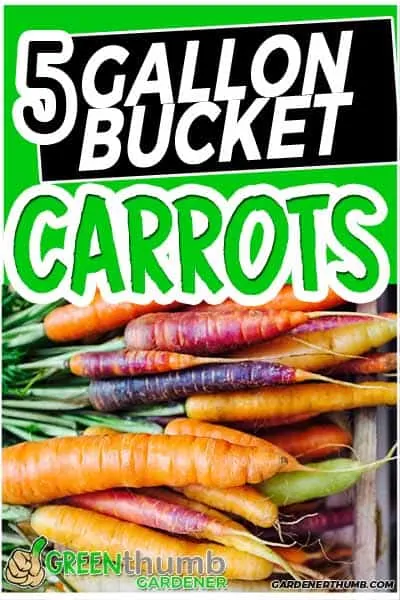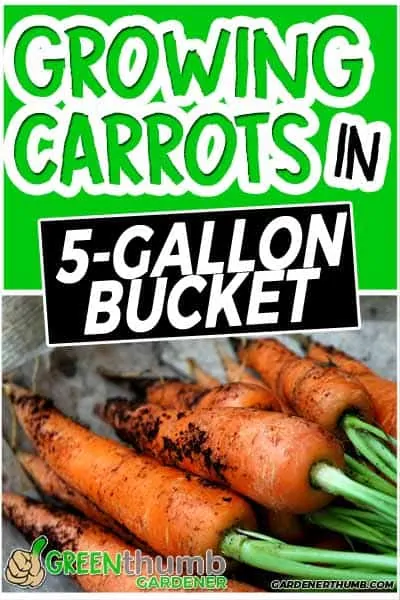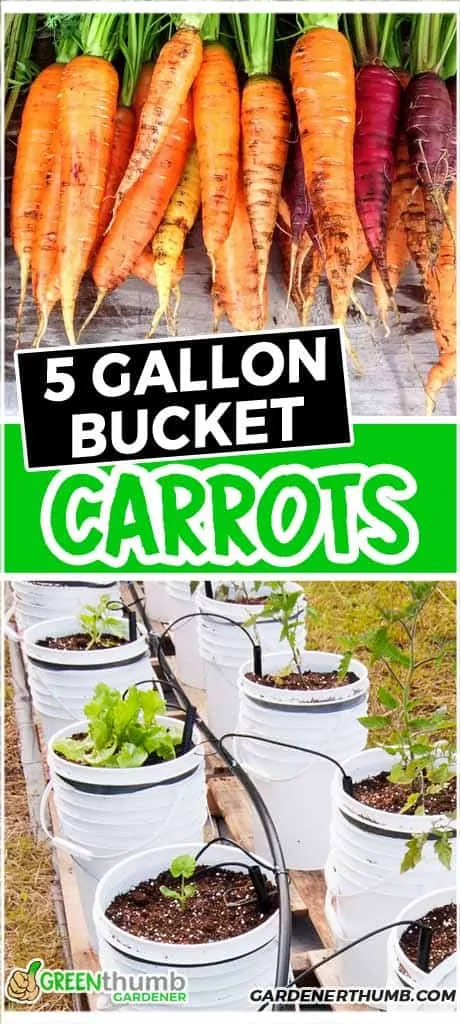Growing Carrots In A 5-Gallon Bucket
Last updated: 01/27/21
You’d agree with me that there’s nothing unusual about growing carrots in containers.
Gardeners have been doing it for years to augment their supplies of whatever they fancy.
Whether it be fruits, vegetables, herbs, or just for the pleasure of enjoying gardening.
But have you heard about growing carrots in a bucket?
Green thumb Gardener occasionally links to product and/or services offered by vendors to assist you with all your gardening needs. Some of these may be affiliate links, meaning we earn a small commission if items are purchased.
Want to Download a Garden Hack Guide for FREE

Enter your email below and we will send you a guide to help you SAVE money in your garden.
The amazing truth is that it can be done.
That’s saying a lot for people with limited space who live in urban sprawls.
Even city dwellers can master growing carrots in a 5 Gallon bucket. It offers them the perfect gardening solution.
Below, you will find out why to make the switch to container gardening.
You will learn what are its negatives, and growing carrots in 5-gallon buckets!
Reasons to Grow Carrots in a 5 Gallon Bucket
Be still for a bit and think about why you should use buckets to grow your carrots:
- Choices – You’d probably be amazed to know how many types of vegetables, including carrots, are perfect for growing in ordinary 5 Gallon buckets. Tomatoes, cucumbers, melons, peppers, carrots, and radishes are only some of the vegetables that can be grown in a bucket.
- Less Space – The beauty of this newly found bucket method for growing a host of vegetables and in particular, the standard carrot, the main subject of this article, is that you don’t really need a huge space in your backyard to plant and grow food for your family.

- Easy Start-Up – All you need is the desired number of buckets that you already have or ones that you can purchase at a fair price. Look around you and you’ll notice that people are planting vegetables in containers and are producing tons of it, but they haven’t tried using buckets yet.
- Repurpose Unused Space – Growing in buckets can create productive space from stagnant space. Whereas limited space would be unused and therefore unproductive, using buckets would change the situation by using even cramped space and transform it into a beehive of activity and growth.
- Eliminate Issues – You’d minimize or even eliminate many of the issues that arise from ordinary gardening techniques in your backyard. Your plants and veggies would be safe from being stepped on, eaten by rabbits, bad potting soil, downpours, sprouting weeds, and of course they’d be very simple to look after.
- Cost-Efficient – Why invest in setting up raised beds which are very expensive to put in place and consume more space? Wouldn’t the cheaper and space-saving option of using buckets be a better proposition with the same positive outcome? It’s obvious don’t you think?
- Versatile – Buckets are light and hence more portable and keeping in mind how the sun traverses the sky above, you can easily relocate them to fall directly under direct sunlight boosting photosynthesis and growth.
- No Digging Needed – Using buckets means no digging or replanting that places you carrots at risk of dying. You only need to lift the buckets and place them wherever and whenever you need to.
Things to Keep in Mind with Container Gardening
Certain gardening activities listed below are essential to ensure proper growth in a bucket, especially to grow carrots.
Frequent Watering
Unlike other vegetables such as zucchini and other squash species, carrots don’t often require much water but they do need water at certain intervals.
The perfect time to start watering your plants in your bucket is daily after planting the seeds.
You don’t want the seeds to dry out. you can reduce to every other day once larger.
If you can afford them, a drip irrigation unit or a soaker hose may be the perfect equipment to use.
If they prove to be too expensive for your gardening, then a garden hose sprayer would be the perfect watering equipment for you to provide the one inch of water your plants need.
You can do your own checking to determine whether or not to water your plants.

Dig to about 4 inches deep somewhere near the plant. If the soil is wet, that’s fine but if it’s dry, you must apply water.
Make sure that the water flow is slow to avoid washing away the potting mix from the top or bottom of your perforated bucket.
Planting
Look for seeds that are a mixture of white, yellow, and different orange hues to add color and novelty to your gardening venture.
Then add purple carrot seed to your seed mixture and mix them together. Place 10 to 15 seeds in the bucket to allow the carrot to grow normally.
Once the seedlings sprout, take care to select the weakest seedlings and cut them away from the bunch of sprouted seedlings without pulling them.
This task is needed if you happen to put more seeds into the bucket than needed. Only the stronger seedlings will survive and grow.
Types of Carrot
The main types of carrots include the Imperator, Chantenay, Danvers, and Nantes and these can be added to the Purple Dragon and Purple Haze.
From experience, the Purple Haze proved slimmer with a soft texture and particularly delectable when picked young.
The yellow and white varieties are also favorites with their sharp contrasting hues to the purple varieties.
When mixed together, they offer a cuisine delight in any carrot dish at home or at a special event.

Further Reading
Soil Requirements
The perfect soil mixture for carrots is made up of loose and light soil with a little perlite added into the mix which allows the carrots to grow straight down in an elongated form with a pH of 6.0 to 6.8.
Placing dug up garden soil into the buckets must be avoided because of its hardness which prevents seedlings from sprouting.
Rocky soil is just as bad for not allowing the carrots to grow freely downwards and they become short and stunted sometimes developing two other protruding (abnormal) legs.
Days to Sprout
Even though carrots do not need lots of water, they need to be always moist.
So if there’s a lack of rain, you must keep them watered manually to prevent the surface and don’t dry up completely so that the crust develops on the surface.
The first top layer of the soil must always be moist until the seeds sprout which should take place within 14 to 17 days given the right air temperature. The right temperature for seedlings to grow is a constant 13°C or above.
Below this temperature, the seedlings will automatically stop growing but will resume their growth with a rise in temperature.
Plants suffer when temperatures rise above 30°C.
Harvesting
When harvesting carrots, look for the plants with large thick greens and pry the carrot tuber out by gently pulling and wiggling them out from the bucket.
Carrots, especially young ones are sweet and delicious when eaten raw or cooked. If you fancy raw carrot, simply wash or brush off the dirt and enjoy it!
How to Grow Carrot in 5-Gallon Buckets
Whether you plant your carrots in containers or in buckets, the methods used to plant them are almost identical except for some minor variations.
Check out this video for further tips:
The simple guidelines & gardening tips listed below will help with growing carrots in buckets:
- Buy several 5-gallon (19 L.) buckets at your nearby local restaurant supply store or commandeer good “food grade” buckets used to deliver bulk food supplies from your local restaurant. Never use buckets that have been used to store toxic materials.
- Use a drill or hammer and nail to puncture holes in the bottom of the bucket for drainage. Water can accumulate fast in a closed bucket so many holes will be needed. The ideal number of holes can be achieved by spacing them at 3-inch intervals from each other.
- Do a facelift to your buckets by painting them all in one or different colors by spraying their surfaces with paint. The colors will lighten up the place where you put them. Placing 2 to 3 inches of gravel in the bottom of the bucket will help the drainage.
- Fill the rest of the bucket up with an even mixture of peat moss, planting soil, and compost. Mix them well and leave a little room for planting. Some plants may require higher or lower amounts of compost in the soil. Do not use soil that can harden in the bucket and hinder the growth of your plant.
- Place your plants in the spot you want them to grow. You can always move them later if needed.
- Water daily during dry spells but only when the soil is dry other times.
- While compost is the ideal soil material for carrots, liquid fertilizers may be used once or twice a month to augment the compost and boost the growth of the carrot tuber.
Final Thoughts
These days, wisdom must guide the mind in choosing a vegetable plant that is simple to plant and grow and one that can provide a family with a steady supply of veggies for the family’s table.
It is simple and cheap to grow, is extraordinary at churning out a sustained and bountiful supply of carrots and there’s no hassle in preparing the next crop.
It may be the perfect mainstay for food (veggie) availability for many people.








